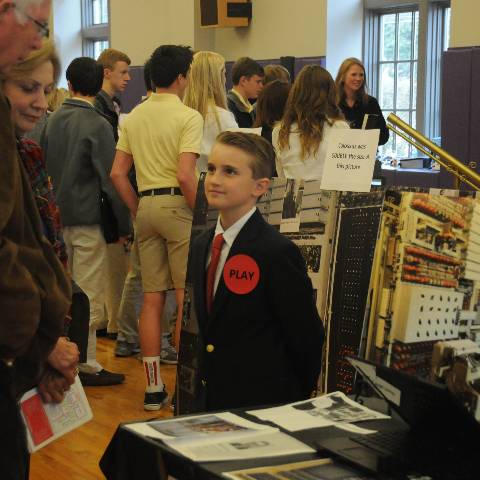This is my third year working as a librarian at Darlington, but only my first year working with the third grade. When I first learned that I was going to become the third grade's librarian, I was especially excited about getting to be a part of the famous Third Grade Wax Museum!
The Wax Museum is an annual project at Darlington. Each third-grade student is assigned a historical figure to research and present about. I first experienced the "Wax Museum" last year when I visited as an observer. I was so impressed by the levels of hard work, poise and professionalism that those 8- and 9-year-old students had put into researching and presenting about famous figures from Georgia's history. I was also in awe of the logistics that must have gone into planning and preparing for such an event! Each student had written a report, created an iMovie presentation, brought in several props, dressed in character, and prepared a speech highlighting interesting facts about his or her historical figure. (Did you know that Margaret Mitchell, author of
Gone With the Wind, was only 49 years old when she was killed by a speeding taxi?)
This year, the third-grade teachers chose "STEAM" (Science, Technology, Engineering, Art and Mathematics) as the theme for their Wax Museum. Each student was assigned an important figure from one of these areas.
For weeks, the students' education in many content areas was specifically directed toward preparation for the Wax Museum. They read about their historical figures, wrote about their historical figures, gained historical perspective on the eras in which their figures lived, created drawings and paintings of their figures, memorized speeches from their figures' point of view, built a Keynote presentation, and even made props related to their figures' lives using the 3-D printer in the Makerspace.
My role in the Wax Museum process was to help the students with their research, particularly with finding reliable resources and creating bibliographies, but also sometimes with interpreting and understanding new information.
Personally, I learned some really interesting facts about the 32 STEAMers. For instance, I never knew that Louis Pasteur's work was inspired by his desire to invent a vaccine after several of his children died of typhoid. It was news to me that Albert Einstein didn't talk at all for the first few years of his life. And I was surprised (and thrilled) to hear about all of the important ways that women like Ada Lovelace, Grace Hopper, Emily Roebling, and Hedy Lamarr have contributed to science, technology, engineering, art, and math.
What are even more amazing (and educational) for me, however, are the observations I've been able to make about the learning process of my young students. Our third-graders attacked this long-term project with a ferocious kind of intellectual curiosity that has impressed and inspired me! Every time I would see the third-graders throughout January, February and March, they would run up to me bursting with excitement to share a new interesting or surprising fact they had learned. Mr. McConnell and Mrs. Clements are
masters at developing engagement in their students, and I bow to them! As the weeks went on, it was clear to me that their students were truly interested in
understanding their historical figures, not just in collecting isolated facts to string together a report and a speech.
Many times, students would ask me questions about technology, terminology or historical context that were unfamiliar to them. I would explain to them things like what an engineer's job is, how computers have evolved over the decades, why women of the past might not have been formally educated, and the events that led up to World War II. Many of the Wax Museum figures are famous because they broke gender, race and ethnicity barriers, and it was a very special experience for me to be the first person to explain those topics to children, and to see the understanding and empathy in their eyes when they learned about the types of obstacles that their figures had faced.
So you see, the Wax Museum at Darlington is really about much more than doing research, creating an iMovie and memorizing a speech. For our third-graders, it's about throwing themselves wholeheartedly into a topic, dedicating themselves to a months-long project, and experiencing the success that comes with hard work and focus. It's about learning to present information and express themselves through art, written word, spoken word and costumes. It's about learning how events and people in history connect, understanding how far we've come, and dreaming about where we'll go in the future.
I feel privileged to have been witness to all the behind-the-scenes preparation that goes into putting on the Wax Museum, and overjoyed to have seen it all come together in the Yankee Wrestling Room today. Congratulations to Mr. McConnell, Mrs. Clements, and the whole third grade on their hard work and success!

